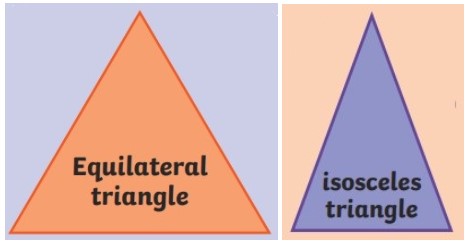An equilateral triangle has all sides equal. An equilateral triangle, for example, is one with all sides measuring 10 cm in length. Because all three sides have the same length, the three interior angles are likewise the same length. As a result, an equilateral triangle may alternatively be thought of as a triangle with three 60-degree angles.
An equilateral triangle, as stated in the introduction, is a triangle with all sides of equal length. An equilateral triangle’s three inner angles are also congruent and equal to 60 degrees.
Equilateral triangles have several important qualities with some fundamental properties:
- An equilateral triangle’s interior sides are all 60 degrees.
- The equilateral triangle is a three-sided regular polygon.
- Only if the circumcenters of the three smallest triangles are the same distance from the centroid is a triangle equilateral.
- Only if the three smallest triangles have the same perimeter is a triangle equilateral.
- The triangle’s orthocenter and centroid are the same places.
- The mean, angle bisector, and height of an equilateral triangle are all identical and represent the triangle’s symmetry lines.
Properties of Equilateral Triangle
- To begin, the circumradius is precise twice the inradius, which is significant since R2r is a result of Euler’s inequality. The equality example is provided by the equilateral triangle, as it is in more complex situations like the Erdos-Mordell inequality.
- The length of an altitude of a triangle is equal to the sum of its distances from three sides if P is any point within an equilateral triangle:
Formula of Equilateral Triangle
The area formula and the perimeter formula are the two significant formulae for equilateral triangles.
- Area of an equilateral triangle
The area of an equilateral triangle may be calculated using the following formula:
A2=3/4a
where ‘a’ is the length of one of the triangle’s sides.
- An equilateral triangle’s perimeter
By summing the lengths of all the sides, we may calculate the perimeter of an equilateral triangle. Because all three sides are equal, we have:
p=3a
where ‘a’ is the length of one of the triangle’s sides.
Centroid of Equilateral Triangle
- The equilateral triangle’s centroid is located in the triangle’s center. Because all of its sides are the same length, finding the centroid is simple.
- We need to draw perpendiculars from each vertex of the triangle to the opposing sides to get the centroid. These perpendiculars are all of the same lengths and intersect at a single place called the centroid.
Circumcenter
- The point of intersection of the perpendicular bisectors of the sides is the circumcenter of an equilateral triangle. The circumcircle here crosses all across the triangle’s three vertices.
- An equilateral triangle is one in which either the incenter, orthocenter, or centroid coincide with the circumcenter of the triangle.
Isosceles Triangle
A triangle with two congruent sides or two sides of equal length is called an isosceles triangle.
An isosceles triangle can be an equilateral triangle, but it is not required. The words “only” or “exactly” are often used in definitions for these triangles. When determining if a triangle is an equilateral triangle or an isosceles triangle, these terms are important.
Many triangles in the real world, including a slice of pizza, may be classified as isosceles. Abstract or difficult forms are sometimes reduced down into simpler shapes, such as triangles.
Legs relate to the two sides that are the same length, while the base refers to the third side. An issue will frequently utilize this terminology to provide information. If you want to learn more about maths concepts in detail, visit Cuemath to book a free session.

Leave a Reply